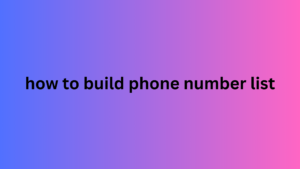Long-tail keyword targeting is an essential aspect of SEO that helps attract niche audiences and improve website rankings. Choosing the right anchor text for long-tail keywords ensures your content is relevant and enhances search engine visibility. Here’s a comprehensive guide to selecting the best anchor text for long-tail keyword targeting.
1. Understand Long-Tail Keywords
Long-tail keywords are phrases consisting of three or more words that target specific queries. These keywords have lower search volume but higher conversion rates due to their specificity. For example how to build phone number list, instead of using “running shoes,” a long-tail keyword might be “lightweight running shoes for marathon training.”
Understanding the intent behind these keywords is crucial. Are users seeking information, making a purchase decision, or looking for reviews? The anchor text you choose should align with the user’s intent to make the content more clickable and relevant.
2. Prioritize Relevance and Context
Relevance is the cornerstone of effective anchor text. The text should accurately describe the linked page’s content and match the long-tail keyword’s context.
For instance advanced nchor text strategies to rank for long-tail keywords, if your keyword is “best SEO tools for small businesses,” your anchor text might be:
- Exact Match: “Best SEO tools for small businesses.”
- Partial Match: “Find top SEO tools tailored for small businesses.”
Avoid generic phrases like “click here” or “learn more,” as they dilute relevance and fail to provide context for both users and search engines.
3. Use a Variety of Anchor Text Types
Diverse anchor text types improve your SEO strategy and prevent over-optimization penalties. Here are common types to consider:
- Exact Match: Matches the long-tail keyword exactly.
- Partial Match: Includes the keyword along with additional words.
- Branded: Uses your brand name, e.g., “XYZ Marketing tools.”
- Generic: General terms like “read more,” though these should be used sparingly.
- Naked URL: Displays the full URL as the anchor text.
Balancing these types ensures a natural link profile and avoids spammy practices.
4. Optimize for User Experience
The ultimate goal of anchor text is to enhance the user experience (UX). Choose language that encourages clicks and guides users to valuable content. Keep your anchor text concise, typically under eight words, to maintain clarity.
For example:
- Instead of “click here for a guide on optimizing SEO for e-commerce websites,” use:
“SEO guide for e-commerce websites.”
Additionally, ensure that the linked content delivers on the promise of the anchor text. Misleading users can lead to higher bounce rates and harm your SEO performance.
Final Thoughts
Choosing the best anchor text for long-tail keyword targeting requires a balance of relevance de cell number, diversity, and UX considerations. By understanding the intent behind long-tail keywords, maintaining contextual accuracy, and optimizing for both users and search engines, you can create an effective anchor text strategy that drives traffic and improves your website’s SEO performance.
Implement these practices to maximize your long-tail keyword efforts and build a stronger, more authoritative online presence.

